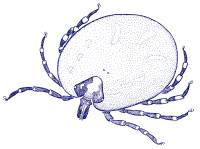Ticks and mites show less sign of segmentation than other arachnids. The only external sign of segmentation being their paired limbs.
Mites
Mites are mainly minute arachnids adapted to a wide range of habitats. Many live in soil or in salt- or fresh- water; others are parasitic on animals and plants. The mouthparts are modified for piercing or sucking. Mites feed on organic debris or the organisms they infest. Their bodies are frequently vividly coloured. Sensory hairs adorn the cuticle and are important in identifying the 30000 species identified to date. Thrombium, the velvet desert mite, is an unusually large mite. Many parasitic mites, like the mange mite and itch mites are of great medical and veterinary importance. Others like the red spider mite are of agricultural importance as parasites of crops.
Ticks
Ticks are larger than most mites; all are parasitic. Ticks have a movable capitulum bearing serrated chelicerae, with which they cut into the host’s skin, and a toothed hypostome, with which to anchor themselves. Once attached they feed on blood. If present in large numbers they can cause serious physical damage to the host. Our tick collection and the importance of ticks, including their role as vectors of a variety of viral, bacterial and protozoal diseases of medical and veterinary importance, are described in detail elsewhere.

Click to visit the tick pages. |
